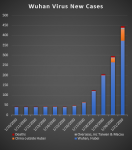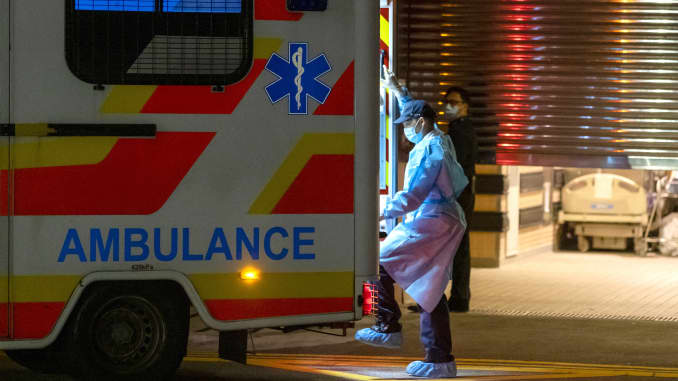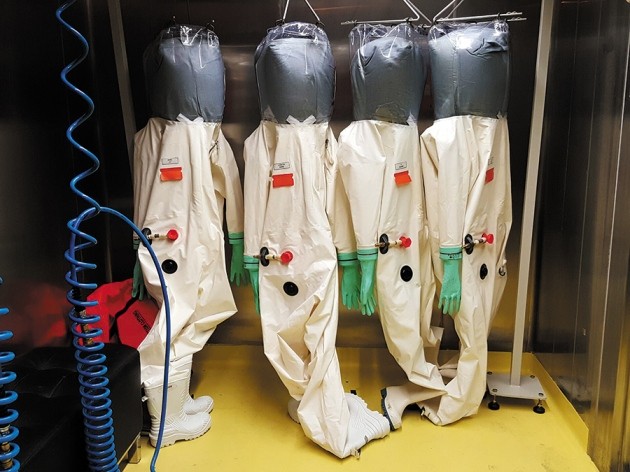Warm Wisconsin
Easy as 3.141592653589..
I think I read a novel like this once - Hmmm - Have to admit this update of the world's largest quarantine is thrilling. I want to see how this plays out.

As I said I am in complete agreement re: the problem being if and when our demand for equipment and personel exceeds our supply.
Not sure where you draw the idea that 80% of those infected need hospitalized. The best and brightest in the field caution we simply do not have a model we can extrapolate numbers from, period. The latest pdf from the WHO that I saw had only 12\300 meeting the criteria for critical, which was the designation that might, but did not necessarily mean ICU n mechanical interventions required. Still a waiting game according to Dr. Majumder and other of the brightest n best informed, at least, last time I checked, and things do change and " mutate" quickly
| WHO to hold another meeting tomorrow, no emergency meeting scheduled for today |
What the heck are they thinking, leaving that stuff? (Unless the rumors are true that it did not originate at the food market, but instead came from the lab. Although, I think if it came from a BSL-4 lab it would be a much deadlier bug)The food market where authorities believe the outbreak began has been shut since 31 December but is still guarded by scores of police officers. It's been disinfected, authorities say. But piles of used, discarded gloves, suits and masks are just lying on the ground.
I had the same question! This seems drastic and I am wondering if it is really much worse than they are admitting. Plus, how are they going to keep 11 million people from leaving?If they are shutting down Wuhan, is it because things are worse than they are saying?
What the heck are they thinking, leaving that stuff? (Unless the rumors are true that it did not originate at the food market, but instead came from the lab. Although, I think if it came from a BSL-4 lab it would be a much deadlier bug)
I had the same question! This seems drastic and I am wondering if it is really much worse than they are admitting. Plus, how are they going to keep 11 million people from leaving?
You’re not, without a full on military blockade, if you start seeing reports of large troop movements to secure the city, buckle up.
Guy that works for hubby in China said that he is hearing they are shutting down Wuhan. Not just public transportation but actually not going to allow anyone in Wuhan to leave. Not confirmed on news yet that I have seen.
Have 2 engineer's there now so panic mode for them in the middle of the night.
NCgirl, as soon as I saw that last night I thought of your husband's guy. Was going to ask if he'd already left. What a nightmare for him and his family back home. Prayers up for them.

The 80% was a WAG. Pick a percentage that needs to be hospitalized and I am good with it.

That is not a good curve...View: https://twitter.com/catecadell/status/1219860239396163585
Cate Cadell @catecadell
The latest data here gives an indication of just how quickly we can expect new #WuhanCoronavirus cases to grow now testing capabilities are being expanded. Virus identified 12 days ago, but testing scope widened since the weekend.
12:51 AM · Jan 22, 2020
View attachment 180116
.


Has anyone actually read which age group is being sickened to worse? I have only had time to skim this thread. The above article says young and old?? Has anyone read the facts on that yet?
All i could offer are my own WAG.... First tho, i suggest we'd only look at those hospitalized AND NEED ING mech intervention..
...then I d look at a bad flu season and steal their number of total cases \ cases hospitalized \ recovered \ deceased for my figures... :: Shruggin :: good thing we prep and have our knowledge, masks, foods and meds : )

 gizmodo.com
gizmodo.com

I hope everyone here realize s that Chinese people are not preppers. They don't have root cellars or food stores. They believe all Food should be as fresh as possible, and most people prefer to shop each day, for the food they will eat each day.Guy that works for hubby in China said that he is hearing they are shutting down Wuhan. Not just public transportation but actually not going to allow anyone in Wuhan to leave. Not confirmed on news yet that I have seen.
Have 2 engineer's there now so panic mode for them in the middle of the night.
^^^ What do you all think happened here? If he was infected through his eyes, that means he either touched his eye with something contaminated or what else? Through the air? Are the virus particles air-born and entering through the eye? (I know it's just supposition that he got it that way.) I keep thinking surely a doctor would not be so stupid to be touching his face or eyes in that environment!One doctor who was early infected is now discharged, and he suspected he was infected through conjunctiva. During his visit to #Wuhan’s hospital, he wore masks the entire time, but didn’t wear goggles. The first symptom, as he described, was conjunctivitis.
Well, that just gave me the warm fuzzies.But worries surround the Chinese lab, too. The SARS virus has escaped from high-level containment facilities in Beijing multiple times, notes Richard Ebright, a molecular biologist at Rutgers University in Piscataway, New Jersey.
This is what I thought too but had no proof as to it's existence. Something got out or was released. I haven't gone through all posts yet so I don't know if this is redundant. 11 Million people have been blocked from leaving or others entering the city of Wuhan. All roads blocked and you are required by law to wear a surgical mask. Hunan is a tourist destination and has incredible landscapes and these landscapes were used in the filming of Avatar-https://www.chinadiscovery.com/hunan-tours. html hope I copied this correctly it's just beautiful! In one of my other posts where I was talking about H5N1 and what to use and the effect that Bayer aspirin on FEVER and how it might have been instrumental in spreading Spanish Flu! The detection process as I understand it, is to check for FEVER on passengers coming into this country on board planes. When you have a FEVER, what do you- Reach for the aspirin. So this detection method is not really the best? How many are going to get through???Also note that the CEO/director of Bayer which had a 27% interest in I.G.Farbin was sent to prison for 7 years for directing/being involved in medical experiments on WW2 prisoners. I often wonder how much has changed??? Don't panic just prepare as needed!I see there is a level IV bio lab in Wuhan. I'm not buying the fish market genesis stories. This thing got out of the lab. A breach accident. Sloppy lab practices I suspect. Blame it on a fish market.
I am not a medical professional nor do I want to derail the thread, just wanted to quickly mention that my understanding re: fever is that you don't want to immediately reach for fever-reducing medications. If you immediately lower your fever when sick, the body is not able to fight the virus as easily. I usually don't take medicine for a fever unless the fever gets really high. Sorry for the thread drift.When you have a FEVER, what do you- Reach for the aspirin.
